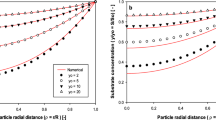Abstract
An analytical model was developed for describing the performance of packed-bed enzymic reactors operating with two cosubstrates, and when one of the reaction products is inhibitory to the enzyme. To this aim, the compartmental analysis technique was used. The relevant equations obtained were solved numerically, and the effect of the main operational parameters on the reactor characteristics were studied.
Similar content being viewed by others
Abbreviations
- C sup*infa,i :
-
local concentration of products in the pores of stage i
- C j,i :
-
concentration of substrate j in the pores of stage i
- D sup*infa :
-
internal (pore) diffusion coefficient for the reaction product a
- D j :
-
internal (pore) diffusion coefficient of substrate j
- J sup*infa,i :
-
net flux of product a, taking place from the pores of stage i into the corresponding bulk phase
- J j,i :
-
net flux of substrate j, taking place from the bulk phase of stage i into the corresponding pores
- K b :
-
inhibition constant
- K m,1, K m,2 :
-
Michaelis constants for substrate 1 and 2, respectively
- K q :
-
inhibition constant
- n :
-
total number of elementary stages in the reactor
- Q :
-
volumetric flow rate throughout the reactor
- R j,i, R sup*infa,i :
-
local reaction rates in pores of stage i, in terms of concentration of substrate j and product a respectively
- S sup*infa,i , S sup*infa,i-1 :
-
bulk concentration of the reaction product a, in the stages i and i — 1, respectively
- S j,0 :
-
concentration of substrate j in the reactor feed
- S j,i-1, S j,i :
-
concentration of substrate j in the bulk phase leaving stages i — 1 and i, respectively
- V :
-
total volume of the reactor
- V m :
-
maximal reaction rate in terms of volumetric units
- y :
-
axial coordinate of the pores
- y 0 :
-
depth of the pores
- α * :
-
dimensionless parameter, defined in Equation (22)
- α 1 :
-
dimensionless parameter, defined in Equation (6)
- α 2 :
-
dimensionless parameter, defined in Equation (6)
- β 1 :
-
dimensionless parameter, defined in Equation (6)
- β 2 :
-
dimensionless parameter, defined in Equation (6)
- ν * :
-
dimensionless parameter, defined in Equation (22)
- ν 1 :
-
dimensionless parameter, defined in Equation (6)
- ν 2 :
-
dimensionless parameter, defined in Equation (6)
- θ * :
-
dimensionless parameter, defined in Equation (22)
- ε * :
-
dimensionless parameter, defined in Equation (22)
- ϱ :
-
volumetric packing density of catalytic particles (dimensionless)
- φ :
-
porosity of the catalytic particles (dimensionless)
- λV sup*infi :
-
dimensionless concentration of reaction product in pores of stage i, defined in Equation (17)
- λj,i :
-
dimensionless concentration of substrate j in pores of stage i; defined in Equation (6)
- ψ j,i-1, ψ j.i :
-
dimensionless concentration of substrate j in the bulk phase of stage i; defined in Equation (6)
- ξ :
-
dimensionless position along the pore; defined in Equation (6)
References
Guzy, S., Saidel, G. M., and Lotan, N., 1989a, Packed-bed immobilized enzyme reactors for complex processes: Modelling of two-substrate processes. Bioprocess Engineering, in press.
Guzy, S., Saidel, G. M., and Lotan, N., 1989b, Multi-molecular process in a packed-bed immobilized enzyme reactor: Numerical simulation and backmixing effects. Biotechnology Progress, in press.
Chang, N. H., 1982, Numerical calculation of effectiveness factors for the Michaelis-Menten type kinetics with high Thiele moduli, AIChE J. 28, 1030.
Moo-Young, M. and Kobayashi, T., 1972, Effectiveness factors for immobilized-enzyme reactions, Can. J. Chem. Eng. 50, 162.
Lee, Y. Y. and Tsao, G. T., 1974, Mass transfer characteristics of immobilized enzymes, J. Food Sci. 39, 667.
Manjon, A., Ibowa, J. L., Gomez, J. L., Gomez, E., Bastida, J., and Bodalo, A., 1987, Evaluation of the effectiveness factor along immobilized enzyme fixed-bed reactors: design of a reactor with Naringinase covalently immobilized into Glycophase-coated porous glass, Biotechnol. Bioeng. 30, 491.
Godia, F., Casa, G., and Sola, G., 1987, Mathematical modelization of a packed-bed reactor performance with immobilized yeast for ethanol fermentation. Biotechnol. Bioeng. 30, 836.
Grynspan, E., 1986, MSc thesis: Enzymic reactors for blood purification. Dept. of Biomedical Engineering, Technion-IIT, Haifa, Israel.
Segel, I. H., 1975, Enzyme Kinetics, Wiley, New York, p. 616.
Author information
Authors and Affiliations
Rights and permissions
About this article
Cite this article
Guzy, S., Lotan, N. Product inhibition in packed-bed immobilized enzyme reactors for complex processes: Modelling of two-substrate processes. Transp Porous Med 5, 153–167 (1990). https://doi.org/10.1007/BF00144601
Received:
Revised:
Issue Date:
DOI: https://doi.org/10.1007/BF00144601




